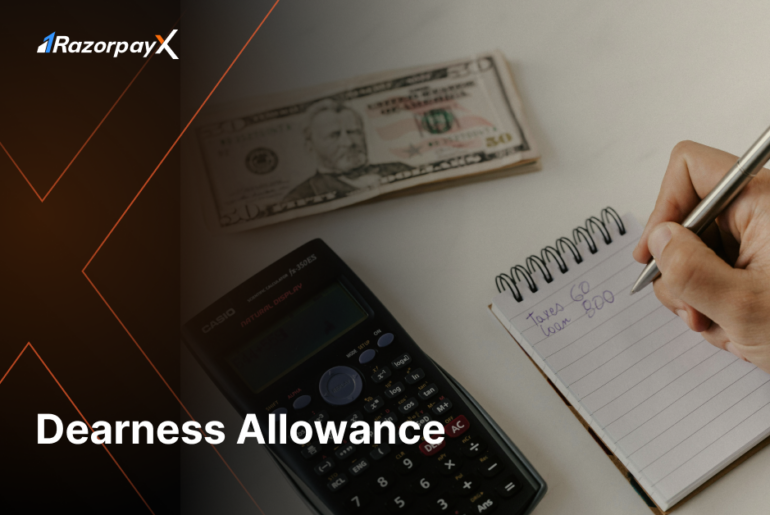Table of Contents
What is Dearness Allowance?
Dearness Allowance (DA) is an allowance provided to current and retired employees of the Central Government to offset the impact of inflation. It is usually a percentage of the employee’s salary.
DA varies according to where the employee resides. Employees in urban areas might get more DA than those living in semi-urban or rural areas.
The percentage of dearness allowance is continuously revised to help people cope with inflated prices and enjoy a good quality of life.
Types of Dearness Allowance
For ease of calculation, DA is divided into two separate categories:
1. Industrial Dearness Allowance (IDA):
Industrial Dearness Allowance is a type of allowance that is extended to public sector employees. The IDA is revised every quarter of the financial year depending on the CPI (Consumer Price Index) to hedge the inflation cost.
2. Variable Dearness Allowance (VDA):
Variable Dearness Allowance is extended to central government employees. The VDA is revised twice a year, i.e., every six months, depending on the increase/ decrease in the CPI (Consumer Price Index).
The VDA depends on three constituents:
- Base Index – The Base index remains unchanged for a pre-decided time.
- Consumer Price Index – The Consumer Price Index changes every month, causing an increase or decrease in the variable DA.
- Variable DA Amount – The Government must set and revise the minimum wage amount. Usually, the government fixed the Variable DA amount as it remains fixed until any revision happens.
How is Dearness Allowance treated under Income tax?
DA is fully taxable for public sector employees under the Income Tax Act 1961. The dearness allowance component gets added to other taxable income sources like basic salary, House Rent Allowance (HRA) and other allowances.
The component of DA also needs to be declared separately when filing the Income Tax Returns.
In some special cases, DA can be considered exempt from taxation. For example, some retired government employees get free unfurnished accommodation as a part of their retirement benefits. If certain conditions are met, this benefit can be considered tax-free.
How is Dearness Allowance Calculated?
Dearness Allowance is calculated with the All-India Consumer Price Index (AICPI), the location of the employee and the recommendations of pay commissions.
Dearness Allowance is calculated twice every year using the following formulas:
DA for Central Government Employees:
DA % = {(Average of AICPI (Base year 2001=100) for the last 12 months – 115.76)/115.75} x 100
DA For Public Sector Employees:
The following method is used to calculate DA for central public sector employees:
DA % = {(Average of AICPI (Base year 2001=100) for the last 3 months – 126.33)/126.33} x 100
AICPI: All India Consumer Price Index
Dearness Allowance for Pensioners
Retired central government employees receive pensions from the government and are called pensioners. Every change in the salary structure as defined by the Pay Commission is also applicable to retired employees.
DA is not paid to pensioners who reside in a foreign country during re-employment.
Dearness Allowance vs House Rent Allowance
| Feature | Dearness Allowance (DA) | House Rent Allowance (HRA) |
|---|---|---|
| Purpose | To compensate for inflation and rising cost of living | To help employees cover the cost of renting a house |
| Eligibility | Available to government employees and pensioners in India | Available to public and private sector employees in India |
| Calculation | Percentage of basic salary (usually fixed by pay commission) | Depends on factors like city classification, basic salary, and actual rent paid (up to a certain limit) |
| Tax treatment | Fully taxable income | Partially exempt income (up to a certain limit based on city classification and actual rent paid) |
| Revision | Typically revised twice a year based on a price index (like CPI) | No fixed revision schedule |
| Benefit | Applies to all government employees irrespective of their location | Applicable only if you live in rented accommodation |
| Transparency | Calculation method is standardized and transparent | Calculation can vary depending on individual circumstances and employer’s policy |
Role of Pay Commissions in Dearness Allowance Calculation
Pay commissions analyse factors like inflation, cost of living and work demands to develop a new structure for salaries, which includes the dearness allowance component.
They have the authority to determine the method for calculating dearness allowance using basic salary component and the percentage to be multiplied to arrive at the DA amount.
For example, the 7th Pay Commission recommended a 50% multiplication factor for DAs for central government employees.
Current Dearness Allowance Rate
The 7th Pay Commission hiked the dearness allowance from 4% to 50% for all central government employees. The revised DA is effective from January 1, 2024.
For example, lets say a central government employee earns a basic salary of Rs 40,000 a month.
With the current DA rate of 50%, they would get an additional Rs 20,000 per month on top of basic salary. This Rs 20,000 is taxable according to income tax laws.
Frequently Asked Questions
Who grants dearness allowances?
The Department of Expenditure grants dearness allowances.
Why is dearness allowance given to employees?
Dearness allowances are issued to employees so that they can offset the impact of inflation and can manage their funds accordingly.
How is dearness allowance calculated?
Since clearance allowance differs from each sector, you have to multiply the dearness allowance rate for your sector with your basic salary.
Is dearness allowance a part of the basic salary?
No, dearness allowance is not a part of the basic salary.
What is the full form of DA in salary?
DA stands for Dearness Allowance.
When is Dearness Allowance revised for employees?
The Dearness Allowance percentage is revised according to the recommendations of the Pay Commission.
Is Dearness Allowance applicable to employees and pensioners of private sector?
No, DA is only applicable to central government employees.
When is DA merged with basic salary of employee?
In India, Dearness Allowance (DA) for central government employees does not automatically merge with the basic salary upon reaching a specific threshold. One pay commission in the past had recommended this, but is not practiced currently. This is to ensure full transparency for the employers and employees.
Does an employee need to pay tax for Dearness Allowance?
Yes, DA is fully taxable according to income tax laws. There are special cases where DA is partially or fully exempt from taxes, but only if strict conditions are met.
Does DA differ on the basis of work location?
Yes, Dearness Allowance (DA) can differ based on the work location of an employee in India. This is because the cost of living varies significantly across different parts of the country.





